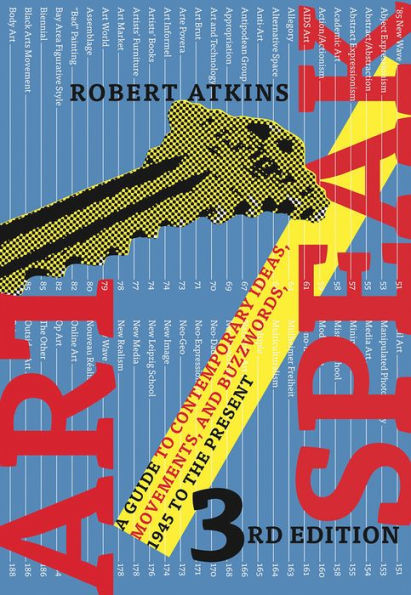Read an Excerpt
Excerpt from:
ArtSpeak
Graffiti Art
WHO: Jean-Michael Basquiat, Crash, Daze, Dondi, Fab 5 Freddy (a.k.a. Freddy Brathwaite), Futura 2000, Keith Haring, Lady Pink, Lee Quinones, Rammellzee, Samo (a.k.a. Basquiat and Al Diaz), Taki 183, Alex Vallauri, Zephyr (a.k.a. Andrew Witten), Zhang Dali (a.k.a. AK-47 and 18k)
WHEN: Mid-1970s to mid-1980s
WHERE: Primarily New York
WHAT: Graffito means “scratch” in Italian, and graffiti (the plural form) are drawings or images scratched into the surfaces of walls. Illicit graffiti (of the “Kilroy was here” variety) dates back to ancient Egypt. Graffiti slipped into the studio as a subject after World War II. Artists such as Cy Twombly and Jackson Pollack were interested in the way it looked, the Frenchman Jean Dubuffet was interested in what it meant as a kind of OUTSIDER ART, and Catalan Atoni Tápies was interested in the ways it could be incorporated into his imagery of urban walls.
During the early 1970s—soon after aerosol spray paint in cans became readily available—New York subway trains were subjected to an onslaught of exuberantly colored graffiti. The words and “tags” (graffiti writers’ names) were soon augmented with elaborate cartoon-inspired images. Most graffitist were neither professional artists nor art students but streetwise teenagers from the Bronx and Brooklyn.
Several milestones marked graffiti’s move from the street to the gallery: the United Graffiti Artists’ 1975 exhibition at New York’s Artists Space; Fab 5 Freddy’s widely discussed spray-painted homage to Andy Warhol’s Campbell’s soup cans in 1980; the Times Square Show, also in 1980, which galvanized the attention of the New York art world; the ongoing support in the form of exhibition opportunities and career counseling provided by Fashion Moda, and ALTERNATIVE SPACE in the Bronx; and ultimately, the development of a graffiti STYLE by professionally trained artists such as Keith Haring.
The popularization of graffiti raised questions of unusual aesthetic and sociological import. Was graffiti vandalism? Or urban folk art? The writer Norman Mailer romanticized it as the anarchic manifestation of social freedom, while such critics as Suzi Gablik charged that ghetto youths were being exploited by a novelty-crazed art market.
The year 1983 saw the zenith of graffiti art, with its first major museum exhibition at the Museum Boijmans Van Beuningen in Rotterdam and the Post-Graffiti show at Sidney Janis’s blue-chip gallery in New York. By mid-decade it already seemed outmoded. Underground “tags” and images designed to be rapidly spray-painted or seen only in motion did not survive the transition to the more conventional two- and three-dimensional formats exhibited in galleries.
The most notable exceptions were the works of Jean-Michael Basquiat and Keith Haring. Their considerable talents brought them critical and commercial success equal to that of any young artist of the day, led to collaborations with Andy Warhol, and (inadvertently) drew a clear distinction between their imaginatively realized visions and the narrower skill of tagging a subway car.
One of Harring’s greatest successes as an ambassador for the expressive possibilities of graffiti was posthumous. The young Chinese artist Zhang Dali, who spent several years in Italy beginning in 1989, came to idolize Haring and his work. In 1993 Zhang returned to Beijing and became the sole graffitist in that city, where public order was more rigorously policed than in New York. (By tagging only the walls of homes marked for demolition—or already demolished—he garnered the sympathy of police.) In addition to his tags,18k and AK47, he created huge, cartoonish silhouettes of his head in pairs: one a “negative” image cut out of the wall and providing a view of the rubble of the traditional courtyard home beyond; and the second a “positive” image spray-painted on the wall and focusing attention on it as a container of domestic life sealed off from public intrusion. His photographs of his activities as a graffitist are poignant: they both document modern ruins and evoke the traditional home and lifestyle that flourished within them. Zhang, who began to spray-paint his silhouettes while still in Italy, is perhaps the only figure outside the original circle of New York graffiti artists who ought to be considered at least an honorary part of it.
Rather than romanticizing the New York origins of graffiti art, it is useful to consider other defining events that made it so short-lived a movement, including the death of African-American graffitist Michael Stewart in 1983. Caught tagging by New York police in a downtown subway station, he was savagely beaten and then transported to a nearby hospital in a coma, dying soon after. Both Basquiat and Haring were dead by 1990—the former, in his mid-twenties, from a heroin overdose and the latter, in his early thirties, from HIV-related causes.



